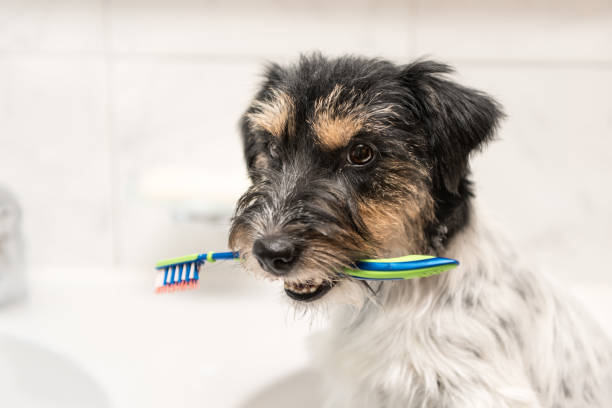What is dog plaque?
Plaque is a tacky layer that forms on the teeth of both humans and dogs. This sticky film primarily consists of bacteria, originating from food particles that remain on the teeth. If left unattended, these bacteria multiply, leading to potential dental issues for your dog. The greater the bacterial growth on your dog's teeth, the higher the risk of developing dental conditions.
How does dog plaque build-up?
The formation of plaque on a dog's teeth initiates following their meal. It occurs due to a chemical reaction activated by bacteria already present in the mouth, combined with food particles and saliva. When these three components converge, the reaction commences, leading to the accumulation of plaque.
Signs of Excessive Plaque on Dog's Teeth
When inspecting your dog's mouth, it's important to be aware of several signs. Take note if your dog exhibits any of the following:
- Inflamed gums
- Discolored teeth
- Tooth loss
- Persistent bad breath
- Presence of pus inside the mouth
If your dog shows any of these symptoms, it is advisable to promptly contact your veterinarian for guidance. Seeking professional advice before attempting any methods to remove plaque from your dog's teeth is essential for the health and well-being of your pet.
Why is dog plaque undesirable?
A significant build-up of plaque can pose a real problem for your dog as it can transform into tartar. The presence of tartar on your dog's teeth may indicate the presence of various conditions, including:
- Gingivitis: This gum condition is commonly associated with dog dental health. In the early stages of gingivitis, your dog may develop bad breath and yellow tartar accumulation on their teeth. If left untreated, the gums may swell, and a red line may appear along the gumline. Advanced stages of gingivitis can lead to gum disease and tooth loss.
- Periodontal Disease: If gingivitis remains untreated, it can progress to periodontal disease. This condition involves the recession of the gums from the tooth, creating a space known as a "pocket." Bacterial infection can occur within this pocket, causing destruction of the gum and supporting tissue around the tooth if left untreated.
- Abscesses: An abscess refers to the collection of pus around one or more of your dog's teeth. This results in swollen and red gums surrounding the affected tooth. The presence of pus causes discomfort and pain for your dog. Regularly checking your dog's teeth by opening their mouth is important to identify any signs of abscesses.
To ensure your dog's oral health, it is crucial to address any signs of plaque and tartar accumulation by consulting with a veterinarian. They can provide appropriate treatment and preventive measures to alleviate dental conditions and maintain your dog's well-being.
How to get rid of plaque on dog teeth
To prevent the problematic build-up of dog plaque, there are several steps you can take:
- Brush your dog's teeth: Aim to brush your dog's teeth at least once a week using a toothbrush designed specifically for dogs. This helps remove plaque and maintain oral hygiene.
- Provide dental treats: Give your dog dental treats that are specially formulated to promote oral health. These treats can help reduce plaque formation and freshen breath.
- Schedule professional cleaning and scaling: Regular visits to a veterinarian for professional dental cleaning and scaling are essential. A veterinary professional can thoroughly clean your dog's teeth, including areas that are difficult to reach with regular brushing.
If dog plaque continues to be a recurring issue despite your efforts, it is advisable to consult with your veterinarian. They can provide guidance and recommend appropriate treatments or preventive measures to address the problem effectively.





